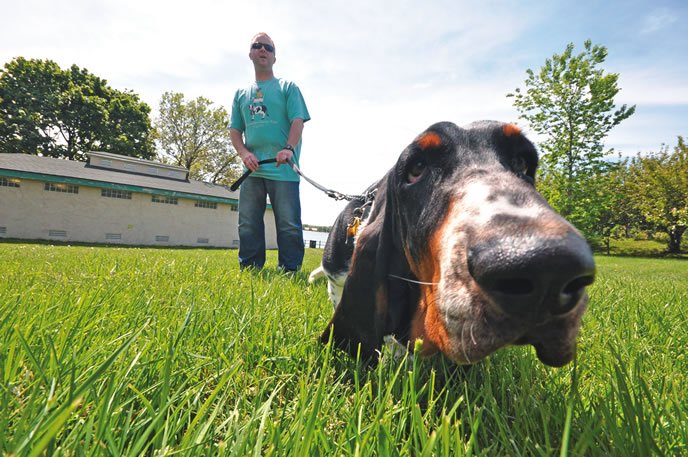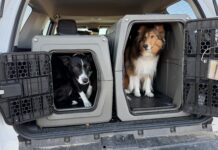
While it may be difficult for us to imagine or remember, many people aren’t comfortable around dogs. For those people, behaviors that dog lovers find charming might be seen as an assault! Even among dog lovers, opinions vary widely when it comes to the behaviors that we find acceptable from our own and other people’s dogs.
Dogs and dog owners can lose access to enjoyable places due to the thoughtless actions of others. As dog lovers, we share a responsibility to be ambassadors for thoughtful, responsible dog ownership. Practice polite dog owner etiquette and be mindful of the following.
1. Control your dog.
If good fences make good neighbors, leashes can help make good dog walkers! It’s important to understand that not everybody wants to meet your dog, no matter how friendly he is. Even leashed dogs, large or small, can be seen as a threat by people who are afraid of dogs.
A dog who is leashed but who appears agitated or stronger than his handler, or who is being allowed by his owner to wander across the sidewalk at the end of a long leash (or, horrors, one of those retractable leashes that allows him to extend his reach to an unpredictable distance), may appear as a terrifying threat to a mom who is taking her newborn baby out in a stroller for the first time, or an elderly person who is fragile or already having trouble with balance.
Some owners may feel justified in allowing their super-friendly, calm dogs to accompany them in public off leash. People should not have to deal with an off-leash dog, no matter how friendly, who has invited himself to their lakeside picnic or was drawn to greet their bike-riding child. Loose dogs can be especially frustrating for fellow dog owners who are out with their leashed dogs. Dogs on a leash often react unfavorably to greetings from loose dogs, specifically because they are on a leash and lack the ability to respond as they see fit to the incursion.
Keep in mind that, often, a leashed dog is leashed because he doesn’t get along well with others! The unexpected and/or uninvited approach by a loose dog can instantly create a major (and completely unfair!) training setback for that dog and his owner, and in extreme cases, puts everyone at hand at risk for a bite.
Even if the leashed dog isn’t offended by the visiting dog, many dogs become overly excited by the unexpected encounters. This creates a situation that is difficult for the owner to manage, and the dog-to-dog contact inadvertently rewards the leashed dog’s over-excited behavior.
What you can do: Abiding by leash laws is the best way to ensure that your dog does not invite himself into situations where he is not welcome. When your dog is off-leash, either because you’re in an open area where off-leash activity is allowed, or because you’ve turned a blind eye to posted leash laws (and we’re certainly not advocating for the latter, but we see it happen), it is your responsibility to make absolutely certain that your dog does not approach, chase, or in any way become a nuisance to any other human, canine, or area wildlife.
Call your dog to you as people with leashed dogs (or dog-less people) approach, and have him wait calmly as fellow outdoor enthusiasts pass by. If you see that your dog’s off-leash activity is creating a difficult distraction for someone with leashed dogs, consider moving to another area, taking a play break, or leash your dog. Simple courtesy goes a long way toward helping dogs and dog owners develop and maintain a shining reputation.
2. Pick the spots where Spot marks.
It goes without saying that picking up after your dog is a basic tenet of responsible dog ownership. But “bagging the business” is just the beginning when it comes to polite toilet practices while in public.
What you can do: First, if you have a yard of your own, encourage your dog to eliminate at home before heading out on a walk.
When enjoying a suburban neighborhood walk with your canine companion, consider limiting his potty-area access to the strip of dirt or grass often found between the street and the sidewalk. Refrain from letting him wander freely at the end of his leash on front yards and any other private property. (I’ve watched owners watch their dogs venture on retractable leashes all the way up to someone’s front door!)
Diligently pick up all solid waste. I like to accumulate good “poop karma” by occasionally bagging a stray poop when I’m out with an extra bag. Yeah, it’s gross, but it helps prevent all dog owners from getting a bad name, and cashing in on “poop karma” makes it slightly less mortifying when the time comes that your dog offers up a third poop on the day you’re out with only two bags and there is no reasonable alternative in sight. (Which seems to happen to everyone at least once!)
When it comes to pitching the poo, think twice before tossing it in the nearest trash can, especially if that can belongs to your neighbor. In my opinion, curbside cans are fair game on trash pick-up day, but empty cans are off-limits. Your neighbors shouldn’t have to spend the week with your dog’s poop in their can. Believe it or not, your dog’s poop stinks, and dog-less neighbors will be even less appreciative of the “deposit.” Carry it home or dispose of it in an appropriate public dumpster.
Finally, consider this: Male dogs should not get a free pass to hike their legs anywhere and everywhere. Consider employing a “no man-made surfaces” rule when it comes to elevated pee-mail. Allowing a pee-a-palooza on public street signs, trash cans, storefronts, newspaper boxes, mailboxes, and public structures is inconsiderate. As former emergency dispatcher Linda Blackwood Coogan of Minden, Nevada, points out, even fire hydrants—often considered the ultimate pooch pee place—have to be serviced by city workers who would likely appreciate a pee-free experience.
3. Make the bark stop here.
Dogs bark for many reasons: as an alert, as a warning, in excitement, out of boredom, etc. Controlling a dog’s tendency to bark is an important part of responsible dog ownership.
If your dog is left home alone for long stretches at a time, consider occasionally checking in with neighbors to get a “read” on your dog’s vocalization when you’re not home, and manage your dog’s playful barking when you are home. This is especially important for apartment dwellers (and renters in general), as “nuisance barking” is often cited by property owners as a key reason they are reluctant to rent to people with dogs.
What you can do: If your dog barks at predictable situations, remove his access to his triggers, or be ready to turn them into training sessions.
For example, many dogs bark excessively at the sight of dogs and people walking past the house. Closing the blinds or otherwise restricting access to the locations where he can see people walking past often reduces the barking. Home-alone hounds often bark out of boredom, in which case, getting up a little earlier to squeeze in a walk or play session before work, coupled with breakfast dispensed via stuffed, frozen Kongs and other enrichment toys (rather than being fed from a bowl) can often provide the mental stimulation needed to reduce or eliminate boredom barking.
If you’re home when your dog sounds the alarm, redirect his attention to a more appropriate activity. Resists the urge to yell for him to “BE QUIET!” Otherwise he may think, “Great! Now everyone is barking!”
Instead, call him to you and ask him to sit, then reward him for sitting. You might need to gently draw him away from the trigger zone in the beginning, but he should quickly learn that leaving the bark-spot and coming to you is definitely worth his while. As a bonus, this also helps desensitize dogs to whatever triggered the barking in the first place, making future outbursts less intense in noise-level and duration. In many cases, the power of the former trigger is reduced and then eliminated over time.
4. Train your dog.
We’re dog lovers and we get along best with those who also love dogs, but that doesn’t mean we love being subjected to especially pushy or untrained dogs. It’s not okay to allow your dog to jump up on, bark or shove spitty fetch toys at, or drape himself across guests as they sit on the sofa. Be respectful of other people’s personal boundaries.
Basic training helps create harmonious interactions between our two- and four-legged friends and family members. Visitors are exciting for dogs, and the excitement often brings out unwanted behaviors. Rather than embarrassingly admit that, “He always does this!” as your guests attempt to politely ignore unwanted advances, help manage the situation, or even better, use it to your advantage.
What you can do: If your dog is especially excited by visitors, attach his leash before you open the door. Grab a handful of tasty treats and reward your dog generously for keeping four feet on the floor as people come in. Mature dogs and dogs with previous training might be able to handle sitting for treats as people enter. Or better yet, for social dogs, keep treats on the porch and instruct visitors to grab a handful before entering, but not to feed the dog unless he’s standing or sitting politely.
If your dog is toy-motivated, teach him to grab and hold a toy as you head to the front door. Many dogs are less likely to jump up when they’re holding something. For dogs who love to retrieve, consider a bucket of tennis balls on the front porch. Similar to the guests-with-treats technique, your visitor enters, asks for a sit, then lobs the toy into the house. As the dog races off to retrieve, the guest can enter the house.
Once guests are inside, consider asking your dog to “stay” at your side or on his bed if he seems overly interested in visiting with guests. If your guests are enjoying the interaction, they’ll let you know it’s fine. If they say nothing as you wrangle up your dog, they probably appreciate the break.
It’s up to you to help your dog make good choices. If you don’t feel like playing “dog trainer” during a particular visit, that’s okay, but rather than leave your dog to his own devices, where he’s likely to practice bad habits, manage the situation by crating him away from company with a stuffed Kong or other enrichment device.
It’s Worth the Work
As a trainer, I regularly travel with a group of dog enthusiast clients on twice-yearly adventures to a nearby coastal and mountain community. One of the highest compliments we’ve ever been paid was by a property manager who said it didn’t even feel like we had dogs. Yes, he saw them when we were out and about, but he rarely heard them or us (no nuisance barking, and no frustrated owners shouting at untrained dogs), and we left no evidence of their stay by not just meticulously picking up waste, but also by covering cabin furniture with our own sheets before inviting the dogs up to cuddle.
Simple acts like these can go a long way toward maintaining, and hopefully increasing, the general public’s willingness to welcome our dog friends.
Stephanie Colman is a writer and dog trainer in Los Angeles.




